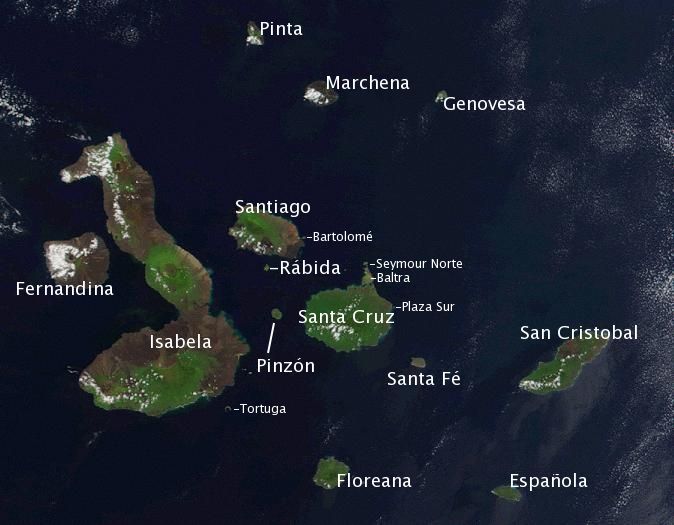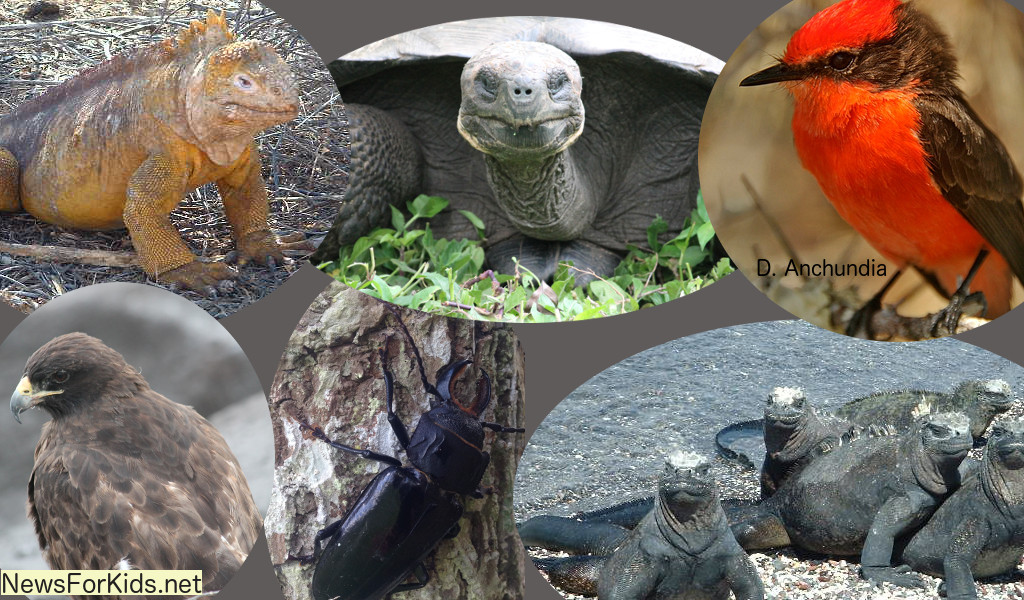Santiago, Galapagos, Ecuador —(Map)
The last person to spot land iguanas on the Galapagos island of Santiago was Charles Darwin – in 1835. Now they’re coming back. Experts believe it will be good for both the iguanas and the island.
The Galapagos islands are a special group of islands 600 miles (1,000) kilometers off the coast of Ecuador. Because the islands are so far from land, they are home to many plants and animals that can’t be found anywhere else.

Storpilot, via Wikimedia Commons.)
But because the Galapagos is in the middle of the sea, in the past it was a favorite stopping place of sailors. Sailors and pirates brought animals that were not from Galapagos, such as rats, cats, dogs, goats, and pigs. Over time, these “introduced” animals have wiped out or threatened many of the animals that make Galapagos special.

(Source: NewsForKids.net [CC BY-SA 4.0].)
But the Galapagos National Park (GNP) and other groups have been working to protect the islands and the special plants and animals that live there. Between 1997 and 2006, experts worked to get rid of the larger introduced animals on many of the Galapagos islands. Now some islands like Santiago are free of them.
On the other hand, another Galapagos island, North Seymour, has almost too many land iguanas, one of the animals found only in Galapagos. It has almost 5,000 iguanas. The island is small and has a limited number of cactus plants, which iguanas eat.

(Source: Benjamint444 [GFDL 1.2], from Wikimedia Commons.)
So the GNP created a plan to move 1,436 iguanas from North Seymour to Santiago which has been missing its iguanas for many years. Capturing the iguanas was the first step. But before the iguanas could be moved to Santiago, they had to be kept alone and watched to make sure they didn’t bring any diseases or plant seeds onto Santiago.
On January 3 and 4, park guards from the GNP released the 1,436 iguanas onto Santiago. In February, the GNP will follow up to see if the iguanas are settling in well, making nests, and finding enough food. The GNP says that the iguanas will play an important part on Santiago, spreading seeds and helping Galapagos plants grow.

(Source: Ministry of Environment, Ecuador.)
Protecting the special plants and animals of Galapagos is a constant challenge. Many challenges come from humans in one way or another. There’s a constant stream of tourists visiting the islands. There is also a large and growing group of people living on the islands, hoping to make a living off of the tourists.
The GNP and other Galapagos groups are working hard to find solutions that are good for both people and protecting Galapagos. Recently, for example, Ecuador’s government made fireworks against the law in the Galapagos. The explosions from fireworks were too stressful for the animals. The islands also have new laws that outlaw certain kinds of plastics that are used just once and then thrown away.
Galapagos Ground Finch – Tougher Than T-Rex
Scientists in England have found a new way of looking at animal strength – by comparing how much an animal weighs to the strength of its jaws.
When they looked at an animal’s “bite force” compared to it’s weight, the scientists found a surprising winner – a tiny bird called the Galapagos Large Ground finch. Measured this way, the jaws of the Galapagos Large Ground finch are about 320 times stronger than the jaws of a T-Rex.

(Source: Peter Wilton [CC BY 2.0], via Wikimedia Commons.)
And in case you’re wondering about humans – we’re weak-jawed. Probably because we learned how to cook food to make it soft.
😕
This map has not been loaded because of your cookie choices. To view the content, you can accept 'Non-necessary' cookies.
